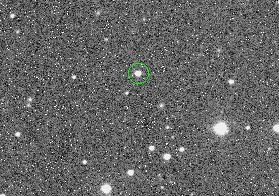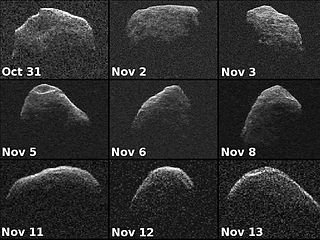Related Research Articles
2063 Bacchus, provisional designation 1977 HB, is a stony asteroid and near-Earth object of the Apollo group, approximately 1 kilometer in diameter. The contact binary was discovered on 24 April 1977, by American astronomer Charles Kowal at the Palomar Observatory in California, United States. It was named after Bacchus from Roman mythology.

69230 Hermes is a sub-kilometer sized asteroid and binary system on an eccentric orbit, classified as a potentially hazardous asteroid and near-Earth object of the Apollo group, that passed Earth at approximately twice the distance of the Moon on 30 October 1937. The asteroid was named after Hermes from Greek mythology. It is noted for having been the last remaining named lost asteroid, rediscovered in 2003. The S-type asteroid has a rotation period of 13.9 hours. Its synchronous companion was discovered in 2003. The primary and secondary are similar in size; they measure approximately 810 meters (2,700 ft) and 540 meters (1,800 ft) in diameter, respectively.

1981 Midas, provisional designation 1973 EA, is a vestoid asteroid, classified as a near-Earth object and potentially hazardous asteroid, approximately 2 kilometers in diameter.
1866 Sisyphus is a binary stony asteroid, near-Earth object and the largest member of the Apollo group, approximately 7 kilometers in diameter.
1863 Antinous, provisional designation 1948 EA, is a stony asteroid and near-Earth object, approximately 2–3 kilometers in diameter. It was discovered on 7 March 1948 by American astronomer Carl Wirtanen at Lick Observatory on the summit of Mount Hamilton, California. It was named after Antinous from Greek mythology.
5011 Ptah is a near-Earth object and potentially hazardous asteroid of the Apollo group. It was discovered by astronomers with the Palomar–Leiden survey on 24 September 1960. The rare O-type asteroid on an eccentric orbit measures approximately 1.6 kilometers in diameter. It was named after the Ancient Egyptian deity Ptah.
3757 Anagolay, provisional designation 1982 XB, is a highly eccentric asteroid, classified as a potentially hazardous asteroid and a near-Earth object of the Amor group, approximately half a kilometer in diameter. It was discovered on 14 December 1982, by American astronomer Eleanor Helin at the Palomar Observatory in California, United States. The asteroid was named after Anagolay from Philippine mythology.
3988 Huma, provisional designation 1986 LA, is an eccentric sub-kilometer asteroid and near-Earth object of the Amor group. It was discovered on 4 June 1986, by American astronomer Eleanor Helin at Palomar Observatory, California. The asteroid measures approximately 700 to 800 meters in diameter and was named after the Huma bird from Iranian mythology.
5653 Camarillo ( KAM-ə-REE-oh), provisional designation 1992 WD5, is a stony asteroid and near-Earth object of the Amor group, approximately 1.5 kilometers in diameter.
14827 Hypnos is a highly eccentric, sub-kilometer-sized carbonaceous asteroid that is thought to be an extinct comet. It is classified as near-Earth object and potentially hazardous asteroid of the Apollo group.
8013 Gordonmoore, provisional designation 1990 KA, is an eccentric, stony asteroid and near-Earth object of the Apollo group, approximately 1–2 kilometers in diameter.
7088 Ishtar, provisional designation 1992 AA, is a synchronous binary asteroid and near-Earth object from the Amor group, approximately 1.3 kilometers in diameter. It was discovered on 1 January 1992, by American astronomer Carolyn Shoemaker at the Palomar Observatory in California. The relatively bright asteroid with an unknown spectral type has a rotation period of 2.7 hours. In December 2005, a 330-meter sized satellite was discovered, orbiting its primary every 20.65 hours.
4055 Magellan, provisional designation 1985 DO2, is a bright and eccentric asteroid and near-Earth object of the Amor group, approximately 2.5 kilometers in diameter. It was discovered on 24 February 1985, by American astronomer Eleanor Helin at Palomar Observatory in California, United States. It was later named for Portuguese explorer Ferdinand Magellan.
2213 Meeus, provisional designation 1935 SO1, is a bright background asteroid from the inner regions of the asteroid belt, approximately 5 kilometers (3 miles) in diameter. It was discovered on 24 September 1935, by Belgian astronomer Eugène Delporte at the Royal Observatory of Belgium in Uccle. The presumed S-type asteroid has a short rotation period of 2.65 hours. It was named for Belgian amateur astronomer and meteorologist Jean Meeus.
7336 Saunders, provisional designation 1989 RS1, is a stony asteroid and near-Earth object of the Amor group, approximately 0.5 kilometers in diameter.
1915 Quetzálcoatl, provisional designation 1953 EA, is a very eccentric, stony asteroid classified as near-Earth object, about half a kilometer in diameter. It was discovered on 9 March 1953, by American astronomer Albert George Wilson at Palomar Observatory, California. It was named for Quetzalcoatl from Aztec mythology.

(214869) 2007 PA8 is an asteroid and slow rotator, classified as near-Earth object and potentially hazardous asteroid of the Apollo group, approximately 1.4 kilometers in diameter.
(31345) 1998 PG is an eccentric, stony asteroid and binary system, classified as near-Earth object of the Amor group of asteroids, approximately 900 meters in diameter. It minor-planet moon, S/2001 (31345) 1, has an estimated diameter of 270 meters.
(86039) 1999 NC43, is an asteroid on an eccentric orbit, classified as near-Earth object and potentially hazardous asteroid of the Apollo group, approximately 2 kilometers in diameter. This suspected tumbler and relatively slow rotator was discovered by LINEAR in 1999.
(154276) 2002 SY50, provisional designation 2002 SY50, is a stony asteroid on a highly eccentric orbit, classified as near-Earth object and potentially hazardous asteroid of the Apollo group, approximately 1.1 kilometers (0.7 miles) in diameter. It was discovered on 30 September 2002, by astronomers with the Lincoln Near-Earth Asteroid Research at the Lincoln Laboratory's Experimental Test Site near Socorro, New Mexico, in the United States. The K-type asteroid has a rotation period of 4.8 hours. It will make a close encounter with Earth on 30 October 2071.
References
- 1 2 3 4 5 6 7 8 9 "JPL Small-Body Database Browser: 4034 Vishnu (1986 PA)" (2015-07-06 last obs.). Jet Propulsion Laboratory . Retrieved 4 July 2017.
- 1 2 3 4 5 "4034 Vishnu (1986 PA)". Minor Planet Center. Retrieved 14 March 2017.
- 1 2 3 Delbó, Marco; Harris, Alan W.; Binzel, Richard P.; Pravec, Petr; Davies, John K. (November 2003). "Keck observations of near-Earth asteroids in the thermal infrared". Icarus. 166 (1): 116–130. Bibcode:2003Icar..166..116D. doi:10.1016/j.icarus.2003.07.002 . Retrieved 14 March 2017.
- ↑ Schmadel, Lutz D. (2007). "(2213) Meeus". Dictionary of Minor Planet Names – (2213) Meeus. Springer Berlin Heidelberg. p. 180. doi:10.1007/978-3-540-29925-7_2214. ISBN 978-3-540-00238-3.
- ↑ "MPC/MPO/MPS Archive". Minor Planet Center. Retrieved 14 March 2017.
- ↑ "LCDB Data for (4034) Vishnu". Asteroid Lightcurve Database (LCDB). Retrieved 14 March 2017.